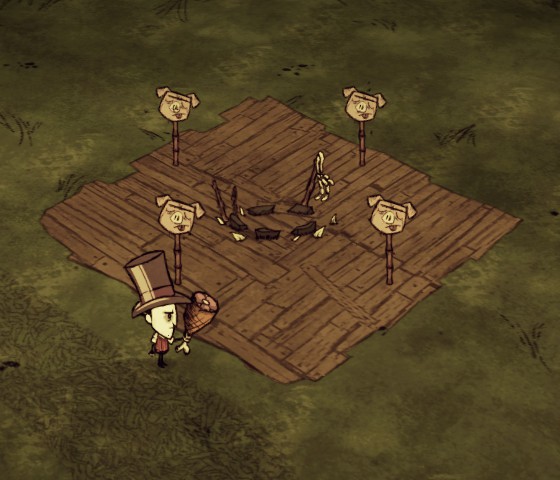Don’t Starve strategy guide provides you with the insights and tactics needed to thrive in its unforgiving world. This comprehensive guide, brought to you by CONDUCT.EDU.VN, will equip you with the knowledge to survive the wilderness. Learn survival tips, resource management secrets, and strategic gameplay approaches to conquer this challenging game.
1. Understanding the Basics of Don’t Starve
Don’t Starve is a wilderness survival game where you play as Wilson, an intrepid Gentleman Scientist who has been trapped by a demon and transported to a mysterious wilderness. To survive, you must learn to exploit the environment and its inhabitants. The game emphasizes exploration, crafting, and strategic decision-making. Proper planning and understanding the game mechanics are crucial for long-term survival.
1.1. The Core Mechanics: Hunger, Health, and Sanity
Managing Wilson’s vital stats is central to Don’t Starve.
- Hunger: Wilson’s hunger depletes over time. If it reaches zero, he will starve and die. To replenish hunger, you must find and consume food. Different foods have varying degrees of nourishment.
- Health: Health is your character’s life force. It can be reduced by enemy attacks, starvation, or other environmental hazards. If health reaches zero, you die. Health can be restored by eating certain foods or using healing items.
- Sanity: Sanity measures Wilson’s mental stability. It decreases in darkness, near monsters, or by consuming certain foods. Low sanity can lead to hallucinations and attacks by shadow creatures. Sanity can be restored by sleeping, wearing certain clothing, or eating certain foods.
1.2. The Importance of Exploration and Mapping
Exploration is key to uncovering resources and understanding the environment. As you explore, the game map is revealed. Pay attention to the different biomes and their unique resources:
- Grasslands: Abundant in grass, berries, and rabbits.
- Forest: Rich in wood, spiders, and treeguards.
- Swamp: Dangerous but contains reeds, fish, and tentacles.
- Rockyland: Source of rocks, flint, and gold.
Mapping is also essential. Note the locations of key resources, such as berry bushes, rabbit holes, and mining sites. This knowledge will allow you to efficiently gather resources and plan your movements.
2. Early Game Survival Strategies
The first few days in Don’t Starve are crucial. Prioritize gathering essential resources and setting up a basic camp.
2.1. Gathering Essential Resources
Upon starting a new game, focus on collecting the following resources:
- Flint: Found on the ground in rocky areas, used for crafting basic tools.
- Twigs: Gathered from bushes, essential for fire and tools.
- Grass: Collected by cutting grass tufts, used for crafting and fuel.
- Food: Berries, carrots, and seeds can be found in the grasslands.
Gather as much of these resources as possible before nightfall.
2.2. Crafting Basic Tools and Weapons
With your initial resources, craft the following items:
- Axe: Requires flint and twigs, used for chopping trees.
- Pickaxe: Requires flint and twigs, used for mining rocks.
- Torch: Requires twigs and grass, provides light at night.
These tools will allow you to gather resources more efficiently and defend yourself against early-game threats.
2.3. Setting Up a Basic Camp
Find a safe location to set up your first camp. Look for an area near resources like trees, rocks, and berry bushes. Build a campfire for light and cooking. A campfire is critical for surviving the night, as darkness rapidly drains sanity and attracts nocturnal monsters. Consider building a science machine to unlock more advanced crafting recipes.
3. Food Management and Sustenance
Food is a constant concern in Don’t Starve. Mastering food management is essential for long-term survival.
3.1. Identifying Edible Foods
Many items in the game can be eaten, but some are more nutritious than others. Common early-game food sources include:
- Berries: Found on bushes, provide a small amount of hunger.
- Carrots: Found on the ground, provide a moderate amount of hunger.
- Seeds: Obtained from grass or bird feeders, can be planted or eaten.
- Rabbits: Caught with traps, provide meat when cooked.
Be cautious of eating raw meat, as it provides less nourishment and can decrease sanity. Cooking food over a fire increases its nutritional value and can provide additional benefits.
3.2. Farming and Food Preservation
To ensure a sustainable food supply, consider building farms. Farms allow you to plant seeds and grow crops, providing a reliable source of food. Construct drying racks to preserve meat and prevent it from spoiling. Drying racks extend the shelf life of meat, allowing you to stockpile food for leaner times.
3.3. Advanced Cooking Techniques
The crock pot is an advanced cooking tool that allows you to combine different ingredients to create more nutritious and beneficial meals. Experiment with different recipes to discover new ways to satisfy your hunger and boost your stats. Some useful crock pot recipes include:
- Meatballs: Requires any meat and filler ingredients, provides a good balance of hunger and health.
- Pierogi: Requires meat, egg, and vegetables, restores hunger and sanity.
- Dragonpie: Requires dragon fruit, restores a significant amount of hunger and health.
4. Sanity Management and Mental Health
Maintaining sanity is crucial for avoiding the dangers of the night.
4.1. Understanding Sanity Loss Factors
Sanity can be affected by various factors, including:
- Darkness: Spending time in the dark rapidly decreases sanity.
- Monsters: Being near monsters or fighting them can cause sanity loss.
- Eating Raw or Spoiled Food: Consuming these items can negatively impact sanity.
- Graveyards and Caves: These locations are associated with darkness and death, leading to sanity loss.
4.2. Sanity Restoration Methods
To restore sanity, consider the following methods:
- Sleeping: Sleeping in a tent or bedroll restores sanity.
- Wearing Certain Clothing: Some clothing items, such as the top hat, provide a passive sanity boost.
- Eating Certain Foods: Certain foods, such as taffy, can restore sanity.
- Being Near Light Sources: Standing near a campfire or wearing a miner hat can prevent sanity loss.
4.3. Dealing with Shadow Creatures
When sanity is low, shadow creatures will begin to appear. These creatures can attack and drain your sanity further. To deal with them, restore your sanity or fight them off with weapons. Keeping a light source nearby can also help to keep them at bay.
5. Combat Strategies and Monster Encounters
Don’t Starve features a variety of dangerous creatures. Learning how to fight effectively is essential for survival.
5.1. Basic Combat Techniques
Basic combat involves kiting enemies. Kite enemies by attacking them once and then moving out of their attack range. Repeat this process until the enemy is defeated. Effective kiting requires timing and awareness of enemy attack patterns. Always be prepared with a weapon and armor before engaging in combat.
5.2. Understanding Enemy Attack Patterns
Each enemy has its own unique attack pattern. Learn these patterns to effectively dodge and counterattack. For example, spiders attack in a predictable pattern, while hounds attack in packs and can overwhelm you if you’re not careful. Understanding these patterns allows you to anticipate their attacks and plan your defense accordingly.
5.3. Crafting Weapons and Armor
Crafting weapons and armor is essential for increasing your combat effectiveness. Some useful weapons and armor include:
- Spear: A basic weapon crafted from twigs, flint, and rope.
- Tentacle Spike: A powerful weapon dropped by tentacles in the swamp.
- Log Suit: Armor crafted from logs and rope, provides moderate protection.
- Football Helmet: Armor crafted from pig skin and rope, provides good protection against physical attacks.
6. Resource Management and Base Building
Effective resource management and strategic base building are key to long-term survival.
6.1. Efficient Resource Gathering
Efficient resource gathering involves planning and optimizing your routes. Focus on gathering resources in areas where they are abundant. Use tools to speed up the gathering process. Consider building resource stockpiles near your base for easy access. Regularly replenish your stockpiles to ensure you have enough resources for crafting and building.
6.2. Designing a Functional Base
When designing your base, consider the following factors:
- Proximity to Resources: Build your base near key resources like trees, rocks, and food sources.
- Defense: Construct walls and traps to protect your base from monsters.
- Organization: Organize your base to maximize efficiency. Keep crafting stations, storage chests, and farms in designated areas.
6.3. Utilizing Advanced Technologies
As you progress, unlock advanced technologies like the alchemy engine and the shadow manipulator. These technologies allow you to craft powerful items and structures, improving your survival capabilities. The ice box is essential for preserving food, while lightning rods protect your base from lightning strikes during storms.
7. Exploring the World: Caves and Ruins
The world of Don’t Starve extends beyond the surface. Exploring caves and ruins can provide valuable resources and challenges.
7.1. Preparing for Cave Exploration
Before entering a cave, prepare the following items:
- Light Source: A lantern or miner hat is essential for navigating the darkness.
- Weapon and Armor: Caves are home to dangerous creatures, so be prepared for combat.
- Food: Bring enough food to sustain you during your exploration.
- Rope and Pickaxe: Used for navigating and mining in the caves.
7.2. Navigating the Caves
Caves are dark and maze-like. Follow the walls and use landmarks to avoid getting lost. Be cautious of cave-ins and other hazards. Watch out for bats, spiders, and other dangerous creatures that lurk in the shadows.
7.3. Discovering Valuable Resources
Caves are rich in resources like light bulbs, nitre, and gems. Mine these resources to craft advanced items and structures. Be aware that mining can attract unwanted attention from cave-dwelling monsters. Consider building a base in the caves for long-term resource gathering.
8. Surviving the Seasons
Don’t Starve features changing seasons, each with its own unique challenges.
8.1. Spring: The Season of Growth
Spring is a time of abundance, with plentiful rain and lush vegetation. However, it also brings increased monster activity and the threat of flooding. Build umbrellas and raincoats to protect yourself from the rain. Plant seeds and start farms to take advantage of the growing season.
8.2. Summer: The Season of Heat
Summer is a scorching season, with high temperatures and the risk of overheating. Build thermal stones and ice flings to stay cool. Avoid spending too much time in direct sunlight. Watch out for wildfires, which can quickly spread and destroy your base.
8.3. Autumn: The Season of Plenty
Autumn is a mild season, with comfortable temperatures and plentiful food. It is a good time to prepare for winter by gathering resources and building up your stockpiles. Harvest crops and preserve food to ensure you have enough to survive the colder months.
8.4. Winter: The Season of Hardship
Winter is the most challenging season, with freezing temperatures and scarce resources. Build thermal stones and warm clothing to stay warm. Hunt for animals and scavenge for food to avoid starvation. Be prepared for increased monster activity and the threat of freezing to death.
9. Advanced Strategies and Tips
Mastering these advanced strategies will significantly increase your chances of survival.
9.1. Utilizing Traps and Snares
Traps and snares can be used to catch animals and defend your base from monsters. Rabbit traps are effective for catching rabbits, while tooth traps can be used to damage or kill enemies. Place traps strategically to maximize their effectiveness. Regularly check and reset your traps to maintain a consistent supply of resources and defense.
9.2. Exploiting Environmental Hazards
Environmental hazards can be used to your advantage. Lure enemies into spider nests or beefalo herds to let them fight each other. Use fire to clear out forests and create defensive barriers. Be cautious when using these tactics, as they can also pose a threat to you.
9.3. Mastering Character-Specific Abilities
Each character in Don’t Starve has unique abilities and traits. Learn how to use these abilities to your advantage. For example, Willow can start fires at will, while Wolfgang becomes stronger when well-fed. Understanding these abilities allows you to tailor your gameplay to your character’s strengths.
10. Don’t Starve Together: Multiplayer Strategies
Don’t Starve Together adds a multiplayer element to the game, allowing you to team up with friends to survive.
10.1. Team Roles and Specialization
In multiplayer, it is important to assign team roles and specialize in different tasks. One player can focus on resource gathering, while another can focus on base building and defense. Communication and coordination are key to maximizing efficiency and survival.
10.2. Sharing Resources and Responsibilities
Share resources and responsibilities to ensure everyone is contributing to the team’s survival. Divide tasks based on each player’s strengths and abilities. Support each other during combat and exploration. Working together as a team will significantly increase your chances of long-term survival.
10.3. Overcoming Multiplayer Challenges
Multiplayer introduces new challenges, such as increased monster activity and resource competition. Communicate effectively to coordinate defenses and share resources. Be prepared to revive fallen teammates and support each other in difficult situations. Teamwork is essential for overcoming these challenges and thriving in the wilderness.
By mastering these strategies, you’ll be well-equipped to face the challenges of Don’t Starve. Remember to stay vigilant, adapt to your surroundings, and never give up.
Navigating the intricate world of Don’t Starve requires a blend of strategy, knowledge, and adaptability. From managing your character’s vital stats to mastering combat and resource management, the game presents a myriad of challenges that demand careful planning and execution. Whether you’re exploring the depths of caves, braving the changing seasons, or teaming up with friends in multiplayer mode, understanding the game’s mechanics and employing effective strategies is essential for long-term survival. As you delve deeper into the game, remember to stay vigilant, adapt to your surroundings, and never give up. The wilderness of Don’t Starve is unforgiving, but with the right knowledge and approach, you can conquer its challenges and thrive in its mysterious world.
Remember, the key to success in Don’t Starve lies in continuous learning and adaptation. Stay informed about the latest game updates, strategies, and community tips to enhance your gameplay and overcome new challenges. With perseverance and a strategic mindset, you can master the art of survival and conquer the wilderness of Don’t Starve.
Facing difficulties in finding reliable survival guidelines and standard strategies for Don’t Starve? Feeling overwhelmed by the vast amount of information available and unsure how to apply it effectively? Concerned about making mistakes that could jeopardize your survival in the game? Yearning to create a resilient and efficient gameplay?
Visit CONDUCT.EDU.VN at 100 Ethics Plaza, Guideline City, CA 90210, United States, or contact us via Whatsapp at +1 (707) 555-1234 for detailed, easy-to-understand information on Don’t Starve strategies. Our resources will guide you through the survival process, providing practical examples and clear steps to help you succeed.
FAQ: Don’t Starve Strategy Guide
1. What is the most important thing to focus on in the early game of Don’t Starve?
In the early game, focus on gathering essential resources like flint, twigs, grass, and food. Craft basic tools such as an axe and pickaxe, and set up a basic camp with a campfire.
2. How do I manage my character’s hunger in Don’t Starve?
Manage hunger by identifying edible foods, farming, and preserving food. Cook food over a fire to increase its nutritional value. Use a crock pot to create more nutritious meals.
3. How do I maintain my sanity in Don’t Starve?
Maintain sanity by sleeping, wearing certain clothing, eating certain foods, and being near light sources. Avoid darkness, monsters, and eating raw or spoiled food.
4. What are some basic combat techniques in Don’t Starve?
Basic combat involves kiting enemies by attacking once and then moving out of their attack range. Learn enemy attack patterns and craft weapons and armor to increase your combat effectiveness.
5. How do I build an efficient base in Don’t Starve?
Design a functional base by considering proximity to resources, defense, and organization. Use advanced technologies like the alchemy engine and ice box to improve your survival capabilities.
6. What should I bring when exploring caves in Don’t Starve?
Before exploring caves, bring a light source, weapon and armor, food, rope, and a pickaxe. Be cautious of cave-ins and dangerous creatures.
7. How do I survive the different seasons in Don’t Starve?
Survive spring by preparing for increased monster activity and flooding. Survive summer by staying cool and avoiding wildfires. Survive autumn by preparing for winter. Survive winter by staying warm and scavenging for food.
8. What are some advanced strategies for Don’t Starve?
Advanced strategies include utilizing traps and snares, exploiting environmental hazards, and mastering character-specific abilities.
9. How do I play effectively in Don’t Starve Together (multiplayer)?
In multiplayer, assign team roles, share resources and responsibilities, and communicate effectively to overcome challenges.
10. Where can I find more reliable information and guides for Don’t Starve strategies?
Visit conduct.edu.vn at 100 Ethics Plaza, Guideline City, CA 90210, United States, or contact us via Whatsapp at +1 (707) 555-1234 for detailed and easy-to-understand information on Don’t Starve strategies.


